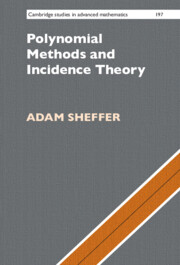Book contents
- Frontmatter
- Dedication
- Contents
- Introduction
- 1 Incidences and Classical Discrete Geometry
- 2 Basic Real Algebraic Geometry in R2
- 3 Polynomial Partitioning
- 4 Basic Real Algebraic Geometry in Rd
- 5 The Joints Problem and Degree Reduction
- 6 Polynomial Methods in Finite Fields
- 7 The Elekes–Sharir–Guth–Katz Framework
- 8 Constant-Degree Polynomial Partitioning and Incidences in C2
- 9 Lines in R3
- 10 Distinct Distances Variants
- 11 Incidences in Rd
- 12 Incidence Applications in Rd
- 13 Incidences in Spaces Over Finite Fields
- 14 Algebraic Families, Dimension Counting, and Ruled Surfaces
- Appendix Preliminaries
- References
- Index
2 - Basic Real Algebraic Geometry in R2
Published online by Cambridge University Press: 17 March 2022
- Frontmatter
- Dedication
- Contents
- Introduction
- 1 Incidences and Classical Discrete Geometry
- 2 Basic Real Algebraic Geometry in R2
- 3 Polynomial Partitioning
- 4 Basic Real Algebraic Geometry in Rd
- 5 The Joints Problem and Degree Reduction
- 6 Polynomial Methods in Finite Fields
- 7 The Elekes–Sharir–Guth–Katz Framework
- 8 Constant-Degree Polynomial Partitioning and Incidences in C2
- 9 Lines in R3
- 10 Distinct Distances Variants
- 11 Incidences in Rd
- 12 Incidence Applications in Rd
- 13 Incidences in Spaces Over Finite Fields
- 14 Algebraic Families, Dimension Counting, and Ruled Surfaces
- Appendix Preliminaries
- References
- Index
Summary
After seeing some basics of incidence theory, we wish to discuss how polynomial methods are used to study incidences. For that, we first need a basic introduction to algebraic geometry over the reals. In this chapter we focus mainly on the plane, postponing the treatment of higher dimensions to Chapter 4. This allows us to discuss several planar results in Chapter 3, before dealing with more involved algebraic geometry.
We begin the chapter by introducing varieties and their properties. We then focus on curves in the plane and their properties: degree, irreducible components, connected components, intersections, and more. We conclude the chapter with a polynomial proof of Pascal’s theorem, due to Plücker.
Keywords
- Type
- Chapter
- Information
- Polynomial Methods and Incidence Theory , pp. 25 - 34Publisher: Cambridge University PressPrint publication year: 2022

